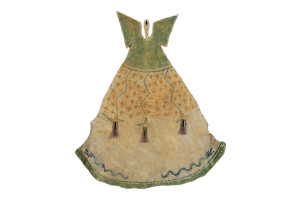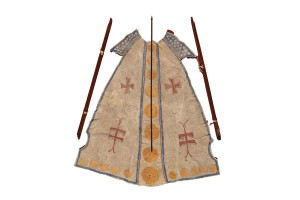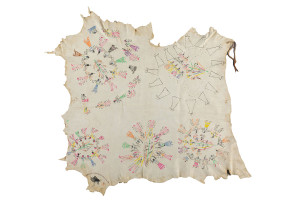
Pictorial Hides and Muslins
Learn more about Pictorial Hides and Muslins
Male warrior artists on the Great Plains traditionally painted personal histories and “war records” on buffalo hides and war shirts. With the decimation of the buffalo herds, the pressure of Euro-American military expansion and colonial settlement in the mid to late 19th century, painting on hide declined. This change was accompanied by the increasing availability of new materials through trade on the Plains. Paper obtained from ledger books and commercially traded muslin cloth gradually replaced hide as mediums of narrative expression. Painting on panels of muslin or canvas cloth developed in the 1880s, having evolved from pictographically painted tipi liners. The tipi liner was an ingenious architectural device which was affixed to the lower interior section of the tipi. With careful positioning the liner functioned to move smoke along the inside wall, and then to escape through a hole at the top. During the reservation period, most Native American families were moved from their traditional tipis into log cabins. The mud and moss chinking between the logs frequently dried out, creating drafts. To combat this problem, panels of cloth were often affixed to the interior walls. Similar in purpose and appearance to earlier hide tipi liners, the cloth cabin liners were painted with depictions of the owner's battle exploits. In the early 1890's, ethnologists working on reservations frequently acquired these cabin liners for museums. Recognizing the economic potential of their work, artists soon took up commercial production of these remarkable historical records.
Status: All
Category: Pictorial Hides and Muslins
Results: 22







Pictorial Hide
attributed to George Bull Child, 1893–1969Southern Piikani (Blackfeet)
Montana





High-resolution images available. Contact Gallery for rights.
